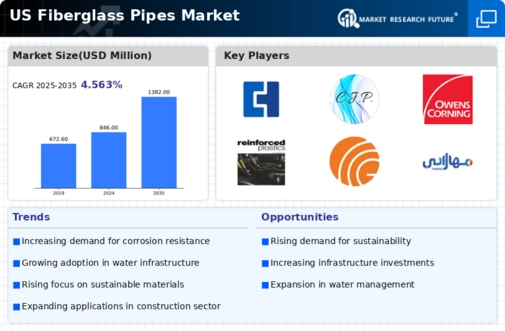Infrastructure Development Initiatives
The ongoing infrastructure development initiatives in the US are likely to bolster the fiberglass pipes market. With the government investing heavily in upgrading water supply and sewage systems, the demand for durable and corrosion-resistant materials is increasing. Fiberglass pipes, known for their longevity and low maintenance costs, are becoming a preferred choice for many municipalities. According to recent estimates, the US infrastructure spending is projected to reach approximately $1 trillion by 2027, which could significantly enhance the fiberglass pipes market. This trend indicates a shift towards modern materials that can withstand harsh environmental conditions, thereby driving growth in the fiberglass pipes market.
Increased Adoption in Oil and Gas Sector
The fiberglass pipes market is experiencing increased adoption within the oil and gas sector, driven by the need for lightweight and durable materials. Fiberglass pipes are particularly advantageous in offshore applications, where their resistance to corrosion and lower weight can lead to significant cost savings. The US oil and gas industry is projected to invest around $200 billion in infrastructure by 2026, which may further propel the demand for fiberglass pipes. This trend suggests that as exploration and production activities expand, the fiberglass pipes market could see substantial growth, particularly in regions with active drilling operations.
Growing Awareness of Environmental Impact
Growing awareness of environmental impact is influencing the fiberglass pipes market positively. As industries and consumers alike become more conscious of their ecological footprint, there is a shift towards materials that are not only efficient but also environmentally friendly. Fiberglass pipes are recyclable and have a lower carbon footprint compared to traditional materials like steel and PVC. This trend aligns with the increasing regulatory pressures on industries to adopt sustainable practices. The fiberglass pipes market stands to benefit as companies seek to comply with environmental regulations while also appealing to eco-conscious consumers.
Technological Innovations in Manufacturing
Technological innovations in manufacturing processes are driving advancements in the fiberglass pipes market. Enhanced production techniques, such as automated winding and advanced resin formulations, are improving the quality and performance of fiberglass pipes. These innovations allow for the production of pipes that are lighter, stronger, and more resistant to environmental factors. As the US construction and infrastructure sectors continue to evolve, the demand for high-performance materials is likely to increase. This trend indicates that the fiberglass pipes market could experience growth as manufacturers adopt new technologies to meet the changing needs of various industries.
Rising Demand for Water Management Solutions
The rising demand for efficient water management solutions is a critical driver for the fiberglass pipes market. As water scarcity becomes a pressing issue in various regions, the need for reliable and sustainable piping systems is paramount. Fiberglass pipes offer excellent hydraulic performance and resistance to chemical corrosion, making them suitable for water treatment and distribution applications. The US water infrastructure is aging, with an estimated 240,000 water main breaks occurring annually, highlighting the urgent need for replacement and upgrades. This scenario presents a substantial opportunity for the fiberglass pipes market, as municipalities seek innovative solutions to enhance water management.




















Leave a Comment